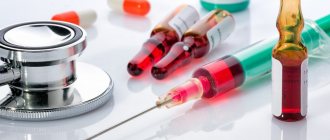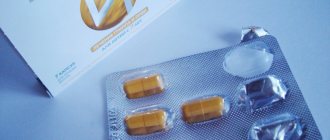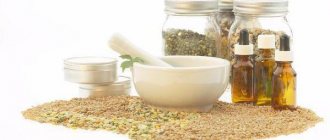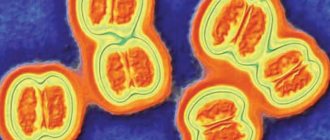Pharmacodynamics and pharmacokinetics
Hellebore water is used as an anti-pediculosis (anti-parasitic) agent. The drug has a pronounced neurotoxic effect against adult lice .
The pharmacological properties of the solution are determined by the properties of hellebore, a poisonous herbaceous perennial from the lily family, which is included in its composition as an active ingredient.
All parts of hellebore contain alkaloids from the cyclopentaneperhydrophenanthrene and glycoalkaloids (steroidal alkaloids), which are natural compounds that combine the basic properties of alkaloids and steroidal saponins .
So, in grass they contain approximately 0.55, in rhizomes - up to 1.3, and in roots - up to 2.4%. From the roots and rhizomes the alkaloid yervin (amino alcohol) and the lycoalkaloid pseudoyervin (chloroform) are isolated.
Moreover, in the summer, the concentration of alkaloids in the plant decreases sharply, and in the spring it increases, therefore, it is in the spring months that hellebore is considered the most poisonous.
The main structural element of all alkaloids are alkalines (amino alcohols or amino alcohols), which are secondary and tertiary bases containing a piperidine ring .
In medical practice, hellebore preparations are used as an effective remedy against ectoparasites , that is, parasites that live on the surface of the body and external organs.
Used as an external remedy, hellebore solution has a pronounced anti-scab effect . In veterinary practice, a decoction prepared from the roots and rhizomes of hellebore is prescribed as a digestive aid and also as an emetic.
Experiments have shown that the complex of ordinary alkaloids also helps to reduce blood pressure while simultaneously increasing the amplitude of heart contractions , provokes irritation of the endings of sensory nerves , causes severe sneezing and coughing attacks .
When taken orally, it causes vomiting . In foreign countries, alkaloids isolated from hellebore are used as an antihypertensive agent .
protoveratrine, which is part of the plant, has a long-term hypotensive effect : the substance reduces systolic and diastolic pressure , provokes bradycardia , dilation of the lumen of blood vessels, and reduces the minute volume of blood flow.
In addition, it reduces diuresis a hypothermic effect to some extent . However, the breadth of therapeutic action of protoveratrine is small, so the best effect from its use is observed in the initial (I-II) stages of hypertension . It is also sometimes used for eclampsia and preeclampsia .
Veratramine, which is part of hellebore, reduces blood pressure and heart rate , has a blocking effect on the pressoreceptors of the carotid sinus , and reduces the excitability of the vasomotor center .
Germitrin and neogermitrin have a stimulating effect on vascular baroreceptors (sensitive nerve endings in blood vessels that sense changes in blood pressure and reflexively regulate its level) and, unlike protoveratrine , on the contrary, increase the excitability of the vasomotor center .
Widespread use alkaloids is difficult due to their high toxicity .
Preparations in which the plant acts as an active substance are used exclusively as an external agent. They are effective as an antifungal , irritant and analgesic .
The use of hellebore significantly increases the tone of skeletal muscles, dilates the vessels of the circulatory system , and excites the nervous system .
Its drugs are used for pain syndromes that accompany neuralgia , myositis , arthritis , gout , rheumatism and various types of musculoskeletal diseases .
The alcohol solution is used externally, rubbing into the scalp, for dandruff and for hair growth . The use of hellebore water against lice : the product has a detrimental effect on the condition of the smooth muscles of the intestinal tract of parasites and their reproductive system, as a result of which they lose the ability to feed and reproduce.
In folk medicine, the drug is also used to combat alcohol addiction .
As a remedy against alcoholism, hellebore water is consumed orally (despite the prohibition of this method of use in the instructions and the disapproval of official medicine).
The mechanism of action of the drug is based on the ability of hellebore to provoke severe intoxication of the body when taken orally. The tincture is mixed into an alcoholic drink without the patient’s knowledge, resulting in the person being poisoned.
alkaloids ( protoveratrine , nervin, etc.) first have a stimulating effect on the central nervous system , and then block it, which is manifested by the following symptoms:
- severe vomiting;
- diarrhea;
- general excitement of the body;
- deterioration of general health;
- a steady increase in muscle tone, which is replaced by spasms;
- acute heart failure.
In almost 100% of cases, the patient requires hospitalization and medical care. This method of using hellebore water assumes that after the experience, the alcoholic, believing that the cause of everything is alcohol poisoning, will forever feel disgusted with it.
However, this treatment of alcoholism causes skepticism and rejection among doctors. Firstly, the human body may not be able to cope with the load, and everything will end in death .
This is due to the fact that the protoveratrine has an extremely adverse effect on the digestive and circulatory systems , as well as on the brain .
Secondly, reviews of the use of hellebore water for alcoholism indicate that having fully recovered after treatment, the majority of those suffering from alcohol addiction return to their addiction.
the alkaloids contained in hellebore are practically not absorbed and do not have a resorptive effect (or the latter is extremely insignificant).
Prolonged use of hellebore water or excessively active rubbing of the drug into the skin can lead to the penetration of the drug into deep tissues and cause the development of various kinds of resorptive effects (in particular, intoxication of the body ).
Advantages and disadvantages
Since, in addition to antiparasitic properties, hellebore water has many other medicinal properties, the use of the product helps to remove not only lice and nits, but also has a positive effect on the condition of the hair and scalp.
The alcohol tincture stimulates blood flow, thereby accelerating local metabolism. Follicles receive more nutrients, vitamins and oxygen. Hair begins to grow faster, becomes thicker, stronger.
The antifungal and antiseptic effect of the drug helps eliminate seborrhea, dandruff, and symptoms of fungal skin diseases. In general , after a course of treatment with hellebore water, the following changes are observed:
- the functioning of the sebaceous glands is normalized;
- symptoms of inflammation on the skin are reduced, wounds and abrasions heal faster;
- hair becomes silky, shiny, and falls out less.
It is important that not only lice and nits are destroyed, but also bacterial microflora and fungal microorganisms that affect the scalp.
The disadvantages of hellebore water include the inconvenience of using the drug, as well as the need for repeated hair treatments. The second point is due to the fact that the product is unable to penetrate under the dense shell and destroy lice eggs. Therefore, after processing the head, you have to carefully select nits. The procedure, for prevention, must be performed at least 2 times.
It is important to know about lice:
- symptoms and signs of the disease;
- what lice and nits look like;
- types of lice, their differences;
- where do lice come from;
- life cycle of head lice development;
- how lice reproduce, speed of development;
- Why lice are dangerous and what diseases they carry.
Side effects
In rare cases, hellebore water can provoke the development of local allergic reactions , which manifest themselves as:
- itching;
- burning;
- tingling;
- tingling;
- erythema (redness of the skin) at the site of application of the drug.
In case of accidental ingestion of the drug, symptoms of poisoning may occur:
- nausea;
- diarrhea;
- dry mouth;
- thirst;
- severe headaches;
- pain in the epigastric region.
In particularly severe situations, disturbances in the rhythm and frequency of contractions of the heart muscle , which are often accompanied by a slowing of the pulse . Sometimes the nervous system , as evidenced by:
- convulsions;
- increased arousal;
- visual disturbances;
- loss of consciousness.
Often the only signs of intoxication with hellebore alkaloids are dyspeptic disorders and a sharp slowing of the pulse with a drop in blood pressure (which is caused by stimulation of the vagus nerve ).
Instructions for use
A remedy for head lice can be purchased at any pharmacy, but many of them contain very dangerous components. Compared to such drugs, hellebore water is not highly toxic, so it is a popular choice. However, the disadvantages of this product include inconvenience in use, especially compared to modern shampoos, sprays and lotions.
Wash your hair with any soap or shampoo.
The treatment algorithm is as follows:
- No need to use conditioner or balm. Then wrap your hair in a towel and dry it slightly.
- Shake the bottle thoroughly until the sediment dissolves.
- Next, you need to take a cotton swab prepared in advance and moisten it with the preparation. All hair, as well as the scalp, should be treated with damp cotton wool. To do this, you need to carefully divide your hair into strands and lubricate it from the very ends to the roots. It is very important to treat the hair roots. Nits are usually located at a distance of about 2 cm from the skin. The maximum number of parasites is located on the temples and on the back of the head, so these areas need to be lubricated with special care.
- When the entire head is moistened with the product, you need to wrap your hair in plastic and wrap it with a towel on top. You should walk in a “turban” for 30 to 40 minutes.
- After the required period of time has passed, you need to rinse your hair with warm water, apply shampoo and rinse it off. Now you can use your favorite conditioner or balm.
- Then you can start combing out with a special anti-lice comb. This way you can get rid of not only dead parasites, but also eggs.
After your hair is dry, comb it with a simple comb.
Hellebore water is not as effective against nits as it is against adults. But it perfectly weakens the connection between parasites and hairs. So combing will be much easier than if you use any other insecticides or regular hair washing.
If as a result of one procedure it was not possible to kill all the lice, and this is a common occurrence, then you can repeat it the next day. If unexpected “tenants” remain on the head even after repeated treatment, then it is allowed to use hellebore water again no earlier than a week later (frequent use of this product can cause poisoning of the patient).
Throughout the week, it is recommended to continue daily combing, which will significantly increase your chances of fighting lice.
Instructions for Hellebore Water: how to use and dosage regimen
As a remedy for lice, hellebore water is used as an external remedy. Before use, shake the bottle with the drug vigorously, after which, after wearing rubber gloves, the solution is applied to damp hair in the amount necessary to wet the hair and skin underneath.
To maximize the effect, the instructions recommend applying hellebore water evenly over the entire surface of the head, not forgetting to treat areas located in the back of the head and behind the ears.
The head is tied with a scarf and the drug is left on the hair for approximately twenty minutes or half an hour. Then the hair is thoroughly washed with shampoo under warm running water and combed well with a fine-toothed comb in order to remove insects killed as a result of the treatment.
Repeated treatment of the head is allowed at intervals of 24 hours. In case of secondary infection with parasites, the procedure is repeated no earlier than seven to ten days later.
lice and nits treatment is the effect on the hair. After using the drug, their condition improves significantly, the hair becomes more manageable, shiny and silky.
The condition of the scalp also improves:
- its fat content is normalized;
- pathogenic microorganisms are destroyed (including fungi that cause dandruff );
- the tone of the blood vessels increases ;
- the hair follicles improves (as a result of this, the hair follicles are much better supplied with oxygen and essential microelements ).
Application for hair growth involves applying hellebore water to the hair approximately once a week. If you have a receding hairline, as well as people who have alopecia as a result of radiation therapy , it is allowed to wipe the hairless areas of the scalp every other day.
The drug is applied using sponges, tampons or cotton wool discs, brushes, brushes. Some people take hellebore water into a medical syringe, distribute it evenly over the partings and then comb their hair.
It is also possible to simply take a plastic bottle with holes in the cork and thus apply the product to the hair roots.
People suffering from alcohol addiction and their relatives also know what hellebore water is. Ingestion of the drug along with a portion of alcohol can provoke symptoms of intoxication in the body, for which the alcoholic will most likely blame the alcoholic drink.
After providing him with medical care and restoring the body, a persistent aversion to alcohol may be noted. However, such “treatment” is quite dangerous, since it often leads to serious consequences for a person’s health and can even cause his death.
If, however, other methods turned out to be ineffective, and the use of hellebore is considered as the only panacea, then it should be remembered that pharmaceutical hellebore water is not used for alcoholism due to the high risk of developing adverse reactions. Instead, traditional medicine advises preparing a decoction from the root of the plant. But when using it for alcoholism , the dosage must be observed extremely strictly.
The recipe for a decoction of hellebore roots and rhizomes is as follows: 1 teaspoon of raw material (dry crushed roots of the plant) is poured with 50 grams of boiling water and left for one hour, then strained through a piece of gauze and put in a cool place.
The resulting decoction can be stored for no more than five days. They use it by adding two drops (no more!) with a pipette three times a day to food and drinks (not alcoholic).
On days when the patient does not drink alcohol, the decoction is not added to food in order to properly develop the emetic and laxative effects . If the expected therapeutic effect from the use of the drug is not observed, the dosage is gradually increased by one drop per day (but not more than fifteen drops).
If even high doses are ineffective, you should stop treatment and seek help from a specialist.
General information
The drug is a yellow-brown, cloudy aqueous solution of an alcohol tincture of the roots and rhizomes of the Chemeritsa Lobel plant (colloquially “puppeteer”). It is produced by infusing hellebore in 70% alcohol (ethyl) and then diluting the infusion with purified water. The percentage ratio of active and excipients is 1:1.
Release form: solution in dark glass bottles of 40, 50, 100 ml. Sold in over-the-counter departments of pharmacies.
Full composition of the drug:
- natural raw materials;
- ethanol;
- distilled water.
What is the therapeutic effect of the drug against pediculosis based on? Hellebore is a poisonous herb that grows in regions with a temperate climate, in the steppe zone of Ukraine and southern Russia. All parts of the plant are extremely toxic because they contain large amounts of natural alkaloid compounds. But it is thanks to alkaloids that puppeteer has medicinal properties - antiparasitic, antiseptic, bactericidal, antimycotic, tonic.
On insects, including hair lice, body lice, and pubic lice, a solution of hellebore tincture has a pronounced insecticidal and neurotoxic effect. The poison, penetrating the parasite’s body, instantly affects the nervous and reproductive systems and blocks the smooth muscles of the intestines of the adult. As a result of using the drug, lice die within half an hour.
The effectiveness in the fight against pediculosis is enhanced by the alcohol component of the solution. Upon contact with ethyl alcohol, the chitinous cover of the insect is damaged, which facilitates the penetration of toxic substances into its internal organs and spiracles. Additionally, alcohol dissolves the adhesive substance that attaches lice and nits to the hairs and degreases the surface of the hair itself. This makes combing out dead parasites and their eggs after using the product much easier.
How many procedures will be required to completely eliminate lice and nits? The overwhelming majority of adult parasites die after a single treatment of the head with hellebore water. Nits are combed out and selected by hand.
A repeated procedure is carried out as a preventive measure and to eliminate lice that hatched from eggs after the first procedure. In case of severe infection, 3-4 procedures will be required.
In general, it is possible to get rid of lice and nits using hellebore water in an average of 2 procedures with an interval of 7 days. The course of treatment for advanced pediculosis does not exceed three weeks.
Attention! If the treatment result is unsatisfactory, stop using hellebore water. To get rid of lice, use antiparasitic drugs recommended by your doctor.
Overdose
Hellebore is a very toxic plant. Enteral administration of it in an amount equal to 1 gram leads to death.
With prolonged treatment, as well as when the doses recommended by the instructions are systematically exceeded, the alkaloids can provoke the development of resorptive effects , which manifest themselves in the form of:
- nausea;
- severe vomiting;
- a sharp decrease in blood pressure ;
- pronounced, which is accompanied by a sharp increase in the amount of secreted saliva and sweat, loose stools , constriction of the pupils , slowing of the pulse rate , a drop in blood pressure , asthmatic breathing ;
- inhibition of cardiac muscle .
of a large amount of alkaloids into the systemic circulation can provoke cardiac arrest . For this reason, oral use of the drug is unacceptable.
To provide first aid in case of accidental ingestion of hellebore water, the victim is prescribed:
- gastric lavage with tannin , which are characterized by their tanning properties;
- oral administration of a suspension of activated carbon or white clay ;
- taking carminative medications ;
- saline laxatives;
- irrigation with a two percent solution of novocaine (if the mucous membranes are affected).
The treatment is specific. anticholinergic drugs (0.1% atropine ), drugs that improve the function of the heart and vascular system , as well as drugs that normalize the function of the gastrointestinal tract .
special instructions
The drug can only be applied to intact skin.
Due to the high probability of a resorptive effect , when using it, avoid contact with the eyes, mucous membranes, wounds, burns or irritated surfaces, as well as in the mouth (if it enters the stomach and bloodstream the drug acts as a strong poison ).
After applying hellebore water, hands should be washed thoroughly with soap.
For preventive purposes, in order to avoid re-infection with parasites , clothing, bedding and underwear should be disinfected simultaneously with treatment.
Precautionary measures
The simple natural composition of a product does not mean it is safe for humans. Hellebore water is extremely toxic! Improper use of a medicinal solution can cause serious consequences for the body, severe, even fatal, poisoning. In this regard, head treatment must be performed with extreme caution, strictly following the instructions.
Before the first procedure, a sensitivity test to the drug is required. A drop of the drug is applied to the wrist or the inner bend of the elbow. If burning, irritation, redness, or itching occurs within half an hour, the product should not be used. The absence of an allergic reaction makes it possible to use hellebore water in the treatment of head lice.
Work with an alcohol solution of hellebore, as with any toxic substances, only with gloves. Especially if there are wounds, scratches, or other damage on the palms and fingers. The procedure is performed quickly to avoid prolonged contact with the insecticide.
An alcohol solution can cause chemical burns to thin tissues of the mucous membrane and skin. Therefore, one should not allow hellebore water to come into contact with the eyelids, eyes, mucous membranes of the mouth, respiratory tract, or ear canals. If trouble occurs, you should immediately rinse off the product with running water.
To prevent toxic fumes from entering the respiratory system, it is recommended to carry out manipulations in the air or in a room with open windows. During the entire procedure, it is necessary to monitor the body's reaction to the effect of the drug. At the slightest sign of illness, hellebore water is immediately washed off the hair.
Attention! Under no circumstances should a toxic substance be allowed to enter the digestive system. Even a tiny dose causes severe intoxication. For this reason, the drug should be kept out of the reach of small children.
Use during pregnancy and lactation
Clinical studies regarding the use of hellebore water by pregnant and lactating women have not been conducted.
For this reason, treatment with the drug to pregnant women only in cases where the benefits to the mother outweigh the potential risks to the unborn child. Treatment is carried out according to strict indications and under the constant supervision of the attending physician.
If it is necessary to prescribe hellebore water to lactating women , then stop breastfeeding for the period of treatment.
What is hellebore?
Hellebore water is made mainly from a herb called hellebore. But one very important detail must be said that this herb is actually very poisonous. Its use in medicine is determined by its root. Before making this miracle water, experts cut off the roots of hellebore. Naturally, they must wear masks and gloves, otherwise the poison of the hellebore roots will make itself felt. After cutting the roots, they are crushed and dried in the sun. This whole process takes place in the fall, when the hellebore ripens.
Reviews of hellebore water
Reviews of hellebore water for lice indicate that despite its low price, the product is very effective and effectively kills not only adults, but their larvae.
The average rating of the drug on various forums and review sites is 4.5 points on a five-point scale. Perhaps, many consider the only disadvantage of hellebore water to be the side effects that occur after its use, namely, tingling and slight burning at the sites of application.
The advantages include:
- cheapness of the product;
- high efficiency in the fight against lice (some reviews suggest that hellebore water was often more effective than its more expensive analogues);
- effectiveness in the fight against scabies .
In addition, the drug has established itself as an inexpensive and reliable means for hair growth and strengthening. By irritating the scalp, hellebore water increases vascular tone , thereby stimulating blood flow and improving the processes of nutrition of hair follicles and supplying them with sufficient oxygen.
As a remedy for alcoholism , hellebore water has received rather mixed reviews. Some people note its effectiveness, however, most medical professionals agree that the risks to the patient outweigh the possible benefits of treatment.
For this reason, before using the drug, you should carefully weigh the pros and cons, and also consult with a specialist.
How to use
What is needed for the procedure
- a bottle of hellebore water;
- cotton wool (tampon) or sponge, a piece of gauze, a syringe without a needle;
- shower cap or cellophane (plastic) bag;
- scarf or towel;
- latex gloves;
- neutral (baby) shampoo;
- comb + fine-tooth comb.
Instructions for use
- The head is washed with shampoo. Wipe, but not dry, with a bath towel.
- The hellebore water in the bottle is shaken vigorously to evenly distribute the sediment. They don't cheat.
- Wear disposable gloves to protect your hands from contact with the toxic substance.
- Hair (wet) is combed. Divided into thin strands. The procedure begins from the back of the head, progressively treating the entire head.
- Wetting the swab in the solution, apply the product to the hair from roots to ends. Wet each strand one by one, and treat the back of the head, behind the ears, and the area above the neck with special care. To prevent the solution from flowing down the neck and forehead, dry the skin along the hairline from time to time with dry cotton wool.
- The hair, completely moistened with the medicinal solution, is covered with a plastic bag (put a shower cap on the head) and wrapped in a scarf. Leave for 30 minutes.
- After the allotted time has passed, the scarf and bag are removed. The drug is washed off first with running water, then with shampoo.
- The hair is blotted with a dry towel and combed.
- Using a thick comb, carefully comb each strand, selecting dead and immobilized lice and nits remaining after washing your hair.
Important! During the procedure, the child should not be allowed to itch or touch his hair with his hands. If this happens, the product must be washed off immediately with soap.
The effectiveness of the procedure depends not only on the correct dosage and uniformity of application of the drug, but also on the quality of subsequent hair combing. The more carefully and attentively the nits are selected, the greater the likelihood of complete removal of the parasites.
If necessary, hellebore water is reused the next day and a week later. To enhance the therapeutic effect, in the interval between procedures it is recommended to use preventive antiparasitic agents with mineral oils and herbal decoctions for rinsing hair.
We recommend reading: measures to prevent head lice.
Price of hellebore water
The drug belongs to the category of affordable medicines: the price of hellebore water in Ukraine varies from 18 to 28 hryvnia. In Russia, you can buy the drug at a price ranging from 9 rubles to 21 rubles.
- Online pharmacies in RussiaRussia
- Online pharmacies in UkraineUkraine
Pharmacy Dialogue
- Hellebore water (bottle 100ml) YAF
110 rub. order
show more
Pharmacy24
- Hellebore water 100 ml solution PAT "Khimpharmzavod" Chervona Zirka", Kharkov, Ukraine
29 UAH. order
Price
The popularity of hellebore water against lice and nits is due not only to the high effectiveness of the drug, but also to its low price. A 100 ml bottle of medicinal solution costs 25–35 rubles on average in Russia.
This volume is enough to treat the head 2–4 times, depending on the length of the hair. Therefore, the cost of the entire course of treatment for pediculosis with hellebore water does not exceed 35 rubles. With a mild form of infection, one bottle will be enough for preventive treatment of 3-4 people against lice and nits.






